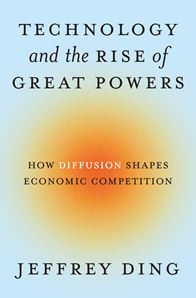Technology and the Rise of Great Powers How Diffusion Shapes Economic Competition
Jeffrey Ding
Princeton University Press
Princeton, NJ, 2024,
320 pp., $29.95
In the 1980s, the US policy establishment was gripped by fear that Japan would overtake the United States as the world’s preeminent economic power through its dominance in pioneer industries, such as consumer electronics and semiconductors. Today, China and the United States are racing to gain mastery over artificial intelligence, which has been compared to electricity as a general-purpose technology (GPT) that could spawn the next economic superpower.
In his new book, Technology and the Rise of Great Powers, George Washington University political scientist Jeffrey Ding argues that competition to get a lock on the next big thing is based on a widely accepted—but misplaced—theory of past industrial revolutions. Popularized by influential historians such as Paul Kennedy, author of The Rise and Fall of the Great Powers, the so-called leading sectors theory holds that the country that is first to adopt a disruptive technology in key industries will rise to global economic dominance. In the First Industrial Revolution, Britain overtook its rivals after breakthrough inventions transformed the textile and iron industries. Similarly, this view attributes the US rise in the early 20th century to its commanding position in chemicals, steel, and motor vehicles.
Ding reexamines the historical record to dispute the leading sectors theory. Its proponents, he contends, fail to explain precisely how innovation fuels long-term economic growth. In Britain’s case, cotton production surged after the adoption of the spinning jenny and the water frame, but the textile industry accounted for only a small portion of subsequent increases in productivity, industrial production, and per capita GDP. And Ding points to Japan’s economic stagnation in the 1990s to argue that the technological pacesetter doesn’t always win the race.
Rather, countries rise to dominance only after innovations percolate through a broad range of sectors over a period of decades, not years. In Britain, according to Ding’s GPT diffusion theory, it was not the iron or cotton textile industries that fueled the Industrial Revolution but the widespread mechanization of industry and the adoption of the factory system. In the United States, the invention of the electrical generator in 1871 didn’t bring widespread electrification of industry until decades later.
It is the broad adoption of technology across the economy that drives growth, not leading industries, Ding argues. He attributes US and British success to “GPT infrastructure”—a system of education and training that cultivates deep pools of engineering skills. In the 1980s, Japan failed to capitalize on its status as technological front-runner because it was slow to adopt widespread computerization.
Today, policymakers in both China and the United States may be misreading the lessons of the past, Ding argues. Neither country can gain a monopoly on artificial intelligence; both focus too much on investments in research and development. They would do better, he suggests, to offer technology training to less-skilled workers who can embed the next GPT throughout the economy. “GPT infrastructure, not the flashy efforts to secure the high ground in innovation, will decide which nation owns the future.”
Opinions expressed in articles and other materials are those of the authors; they do not necessarily reflect IMF policy.










